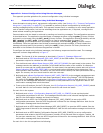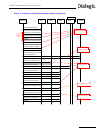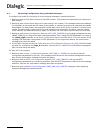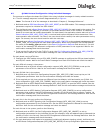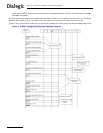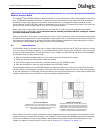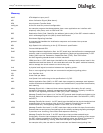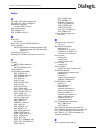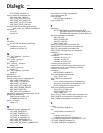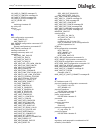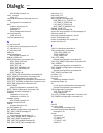
185
Dialogic
®
DSI SS7MD Programmer’s Manual Issue 3
Glossary
AAL5 ATM Adaptive Layer part 5
AIS Alarm Indication Signal (Blue alarm).
ATM Asynchronous Transfer Mode
config.txt A text file used for protocol configuration.
ctu An example program that demonstrates how a user application can interface with
telephony user parts, such as ISUP and TUP.
DPC Destination Point Code. Identifies the address (point code) of the SS7 network node to
which a Message Signal Unit (MSU) should be directed.
DSI Distributed Signaling Interface
gctload A program that handles the initialization sequence and creates inter-process
communication.
HSL High Speed Link conforming to the Q.703 Annex A specification.
IMA Inverse Multiplexed ATM
INAP Intelligent Network Application Part. An SS7 stack layer that defines the messages and
protocol used to communicate between applications (deployed as subsystems) in SS7
nodes. INAP uses the Transaction Capabilities Part (TCAP). See TCAP below.
IS41 An ANSI signaling standard used in mobile networks.
ISUP ISDN User Part. A SS7 stack layer that defines the messages and protocol used in the
establishment and tear down of voice and data calls over the public switched network,
and to manage the trunk network on which they rely.
Link A physical and logical connection between two signaling points.
Linkset One or more signaling links that are connected to adjacent signaling points.
LIU Line Interface Unit.
LFM Linear Feet per Meter.
LSL Low Speed Link conforming to the specification in Q.703.
MAP Mobile Application Part (MAP). An SS7 stack layer supporting messages sent between
mobile switches and databases to support user authentication, equipment identification,
and roaming.
MSU Message Signal Unit. A data unit that carries signaling information for call control,
transaction processing, network management and maintenance. Typically, the MSU is
carried in the Signaling Information Field (SIF) of SS7 messages.
MTP Message Transfer Part. Layers 1 to 3 of the SS7 protocol stack broadly equivalent to the
Physical, Data Link and Network layers in the OSI protocol stack. See also MTP1, MTP2,
and MTP3.
MTP1 Message Transfer Part Level 1. An SS7 stack layer that defines the physical and electrical
characteristics of the signaling links of the SS7 network. Signaling links use DS0
channels and carry raw signaling data at a rate of 48, 56 or 64 kbps.
MTP2 Message Transfer Part Level 2. An SS7 stack layer that provides link-layer functionality.
Ensures that two end points of a signaling link can reliably exchange signaling messages.
It provides error checking, flow control and sequence checking.
MTP3 Message Transfer Part Level 3. An SS7 stack layer that provides network-layer
functionality. Ensures that messages can be delivered between signaling points across
the SS7 network regardless of whether the signaling points are directly connected. It
provides node addressing, routing, alternate routing and congestion control.
mtpsl An example utility that can also be used to activate and deactivate signaling links.




